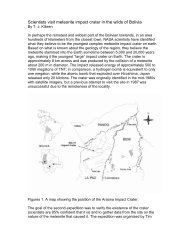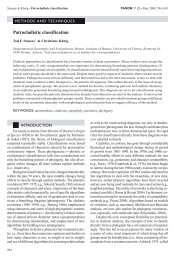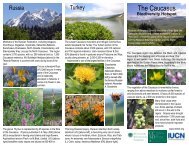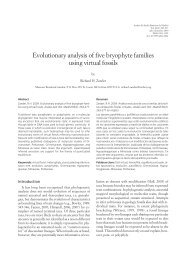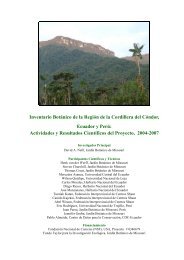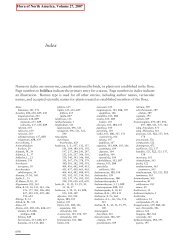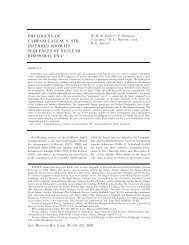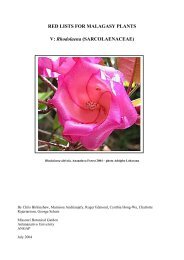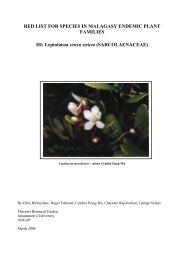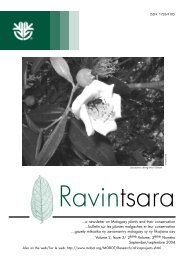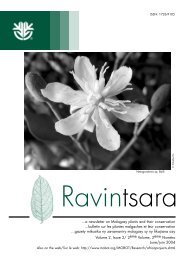red lists for malagasy plants iv: sphaerosepalaceae - Missouri ...
red lists for malagasy plants iv: sphaerosepalaceae - Missouri ...
red lists for malagasy plants iv: sphaerosepalaceae - Missouri ...
Create successful ePaper yourself
Turn your PDF publications into a flip-book with our unique Google optimized e-Paper software.
Rhopalocarpus undulatus Capuron Risk of extinction: Critically Endange<strong>red</strong> (A3c)<br />
Vernacular names: Andrengitra, Lombiroala Conservation recommendations: a) good management of<br />
protected arfeas; b) inclusion of populations in new<br />
conservation sites.<br />
Description:<br />
Medium trees. Leaves small/medium, with pinnate venation,<br />
margin strongly undulate. Inflorescence a many-flowe<strong>red</strong><br />
panicle. Flowers with 4 sepals, 4 white petals, many<br />
stamens. Fruits large, woody/fleshy, globose/lobed.<br />
Habitat:<br />
• Vegetation type: dry deciduous <strong>for</strong>est<br />
• Bioclimate: dry<br />
• Geology: lava, unconsolidated sands, lake and alluvial<br />
deposits, mesozoic limestone<br />
• Altitude: 10 - 315 m<br />
Biology:<br />
• Pollination: probably insect (on basis of flower<br />
characteristics and observation sof bees visiting the flowers<br />
of other Rhopalocarpus species)<br />
• Seed dispersal: probably lemurs (or possibly birds) based<br />
(on fruit characteristics and observations of lemurs (birds)<br />
feeding on the fruits of other Rhopalocarpus species)<br />
Uses:<br />
Timber.<br />
Distribution:<br />
Observations of study population(s)<br />
Location 1: Forêt d’Ambre (12°25’15”S, 49°11’30”E,<br />
Rakotonandrasana 1997)<br />
• Regeneration observed: -<br />
• Tolerant to disturbance: -<br />
• Density: 61 mature ind<strong>iv</strong>idual per ha.<br />
• Abundance: >10,000 mature ind<strong>iv</strong>iduals<br />
P<strong>red</strong>icted future decline:<br />
• because of habitat loss : >80 % (cause of loss = shifting<br />
cult<strong>iv</strong>ation and fire)<br />
• because of exploitation or poor regeneration: unknown, but<br />
decline possible because of exploitation and poor regeneration<br />
resulting from increasing rarity of animal seed dispersers.<br />
Distribution attributes <strong>for</strong> population<br />
• Extent of occurrence: 4,746 km²<br />
• Area of occupancy: 561 km²<br />
• Number of subpopulations: 7<br />
Representation in protected areas:<br />
• Number of subpopulations: 1<br />
• Protected areas: Ankarana RS<br />
Specimens examined: Antsiranana: Ankarana RS, SF(Rakotosihanaka) 10526 ; Diego-Suarez, E. Ursch 145 ; Ambod<strong>iv</strong>ahibe, Service Forestier 15966 ;<br />
Ankarana RS, SF 9380 ; Andaingo, SF(R. Capuron) 27431 ; Sakaramy SF, SF(Rabevohitra) 29976 ; Ankarana RS, H. Humbert 32440 ; Sahaka, Gordon<br />
McPherson 18857 ; Analabe, J.Rabenantoandro et al. 1293 ; Analabe, J.Rabenantoandro et al. 1303 ; Mahavanona, Fidy Ratovoson et al. 740 ; Mahavanona,<br />
Sennen Randrianasolo et al. 405<br />
31





